翻译技巧教案
文字翻译英语技巧初中教案

文字翻译英语技巧初中教案一、教学目标:1. 让学生掌握基本的英语文字翻译技巧,提高学生的英语翻译能力。
2. 通过翻译练习,增强学生对英语语法、词汇和句型的理解。
3. 培养学生对英语翻译的兴趣,提高学生的跨文化交际意识。
二、教学内容:1. 英语文字翻译的基本原则。
2. 英语文字翻译的技巧和方法。
3. 翻译实践:句子、段落和文章的翻译。
三、教学过程:1. 导入:教师通过展示一些中英文对照的句子,让学生感受翻译的过程,激发学生的学习兴趣。
2. 讲解:教师讲解英语文字翻译的基本原则,如忠实于原文、保持语义完整、符合目标语言的表达习惯等。
然后,教师介绍一些翻译技巧和方法,如直译、意译、对译、转换等。
3. 练习:教师给出一些句子、段落和文章,让学生进行翻译练习。
在学生翻译过程中,教师给予指导和帮助,解答学生的疑问。
4. 讨论:学生分组讨论翻译练习中的难点和困惑,分享各自的翻译心得。
教师总结讨论成果,给出正确答案和解释。
5. 总结:教师总结本节课的翻译技巧和方法,强调学生在翻译过程中要注意的问题。
6. 作业:教师布置一些翻译作业,让学生课后巩固所学知识。
四、教学评价:1. 课堂参与度:观察学生在课堂上的积极参与程度,了解学生的学习兴趣。
2. 翻译练习:评估学生的翻译作业,了解学生对翻译技巧和方法的掌握情况。
3. 学生反馈:收集学生的学习反馈,了解学生在翻译过程中的困难和问题,为下一步教学提供参考。
五、教学策略:1. 实例教学:通过展示具体的中英文对照例子,让学生直观地感受翻译的过程。
2. 互动教学:鼓励学生积极参与课堂讨论,提高学生的翻译实践能力。
3. 个性化指导:针对学生的不同需求,给予个性化的翻译指导,帮助学生提高翻译水平。
4. 文化导入:讲解英语和中文的文化差异,提高学生的跨文化交际意识。
六、教学资源:1. 中英文对照材料:提供一些句子、段落和文章,用于翻译练习。
2. 翻译教材:为学生提供翻译相关的教材和参考书,方便学生课后自学。
初中文言文及翻译技巧教案
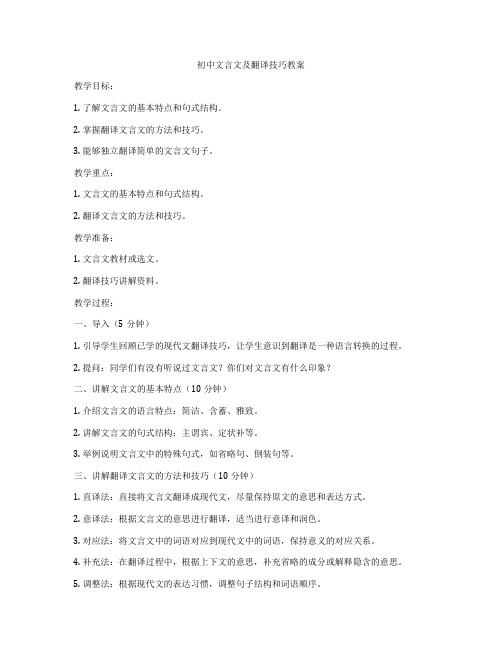
初中文言文及翻译技巧教案教学目标:1. 了解文言文的基本特点和句式结构。
2. 掌握翻译文言文的方法和技巧。
3. 能够独立翻译简单的文言文句子。
教学重点:1. 文言文的基本特点和句式结构。
2. 翻译文言文的方法和技巧。
教学准备:1. 文言文教材或选文。
2. 翻译技巧讲解资料。
教学过程:一、导入(5分钟)1. 引导学生回顾已学的现代文翻译技巧,让学生意识到翻译是一种语言转换的过程。
2. 提问:同学们有没有听说过文言文?你们对文言文有什么印象?二、讲解文言文的基本特点(10分钟)1. 介绍文言文的语言特点:简洁、含蓄、雅致。
2. 讲解文言文的句式结构:主谓宾、定状补等。
3. 举例说明文言文中的特殊句式,如省略句、倒装句等。
三、讲解翻译文言文的方法和技巧(10分钟)1. 直译法:直接将文言文翻译成现代文,尽量保持原文的意思和表达方式。
2. 意译法:根据文言文的意思进行翻译,适当进行意译和润色。
3. 对应法:将文言文中的词语对应到现代文中的词语,保持意义的对应关系。
4. 补充法:在翻译过程中,根据上下文的意思,补充省略的成分或解释隐含的意思。
5. 调整法:根据现代文的表达习惯,调整句子结构和词语顺序。
四、翻译实践(15分钟)1. 给学生发放一篇简单的文言文,要求学生独立进行翻译。
2. 学生在翻译过程中可以参考教材或教师的讲解资料。
3. 教师巡回指导,解答学生的疑问,并给予适当的鼓励和评价。
五、总结和作业布置(5分钟)1. 学生总结今天所学的文言文基本特点和翻译技巧。
2. 教师布置作业:翻译一篇中等难度的文言文,要求学生运用所学的翻译技巧。
教学反思:本节课通过讲解文言文的基本特点和句式结构,让学生对文言文有了初步的了解。
接着讲解了翻译文言文的方法和技巧,并通过实践让学生独立进行翻译。
在教学过程中,要注意关注学生的学习情况,及时解答学生的疑问,并给予适当的鼓励和评价。
作业布置要适度,既要让学生有足够的练习机会,又要避免过大的负担。
英语四级翻译技巧讲解教案及反思

英语四级翻译技巧讲解教案及反思教案标题:英语四级翻译技巧讲解教案及反思教案目标:1. 通过本课的学习,学生将能够了解英语四级翻译的基本要求和技巧。
2. 学生将能够应用所学的翻译技巧,提高英语四级翻译的准确性和流畅度。
教学内容:1. 英语四级翻译的基本要求2. 英语四级翻译的常见技巧3. 英语四级翻译的练习和实践教学步骤:1. 导入(5分钟)- 引入话题:英语四级翻译的重要性以及对学生的影响。
- 提问学生:你们对英语四级翻译有什么了解?2. 探究(15分钟)- 介绍英语四级翻译的基本要求:- 准确性:翻译要忠实于原文的意思,不添加或省略信息。
- 流畅度:翻译要符合英语表达习惯,通顺易读。
- 语法和词汇:翻译要正确应用英语语法和词汇。
- 解释英语四级翻译的常见技巧:- 直译:逐字逐句翻译原文,保留原文的结构和语法。
- 意译:根据原文的意思进行翻译,不拘泥于原文的词序和结构。
- 省略:根据上下文和语境,省略一些无关紧要或重复的信息。
- 补充:根据需要,增加一些缺失的信息,使翻译更完整。
- 转换:将某些特定的表达方式转换为英语的习惯表达方式。
- 举例说明各种技巧的应用,并让学生进行模仿和练习。
3. 实践(20分钟)- 分发练习题目,让学生进行英语四级翻译的练习。
- 学生互相交流并讨论各自的翻译结果。
- 教师给予学生反馈和指导,帮助他们改进翻译的准确性和流畅度。
4. 总结(10分钟)- 提醒学生英语四级翻译的重要性和实践的必要性。
- 总结本课所学的英语四级翻译的基本要求和常见技巧。
- 鼓励学生进行更多的练习和实践,提高翻译水平。
教学反思:本节课的教学目标是让学生了解英语四级翻译的基本要求和技巧,并能够应用所学的技巧进行翻译练习。
通过引入话题和提问学生,我成功地激发了学生的学习兴趣和思考。
在探究环节,我清晰地介绍了英语四级翻译的要求和技巧,并通过举例和练习让学生进行实际操作。
在实践环节,学生积极参与练习和讨论,互相交流和学习。
《翻译技巧》教案
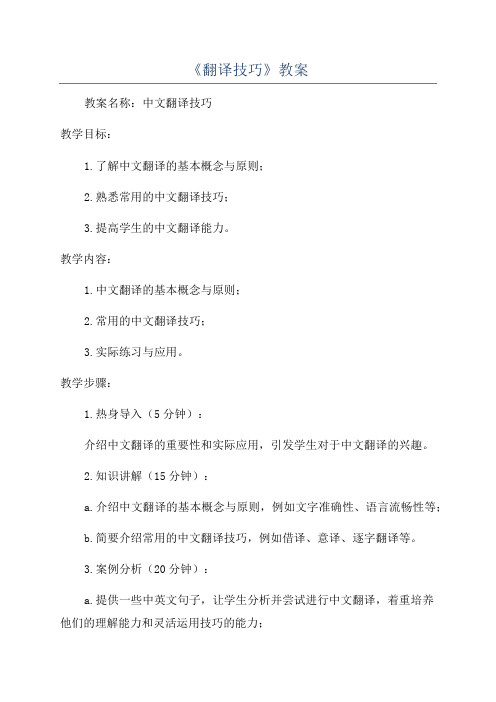
《翻译技巧》教案
教案名称:中文翻译技巧
教学目标:
1.了解中文翻译的基本概念与原则;
2.熟悉常用的中文翻译技巧;
3.提高学生的中文翻译能力。
教学内容:
1.中文翻译的基本概念与原则;
2.常用的中文翻译技巧;
3.实际练习与应用。
教学步骤:
1.热身导入(5分钟):
介绍中文翻译的重要性和实际应用,引发学生对于中文翻译的兴趣。
2.知识讲解(15分钟):
a.介绍中文翻译的基本概念与原则,例如文字准确性、语言流畅性等;
b.简要介绍常用的中文翻译技巧,例如借译、意译、逐字翻译等。
3.案例分析(20分钟):
a.提供一些中英文句子,让学生分析并尝试进行中文翻译,着重培养
他们的理解能力和灵活运用技巧的能力;
b.鼓励学生与同学间分享自己的翻译成果,并进行讨论和互动。
4.综合练习(15分钟):
a.提供一篇中英文文章,要求学生翻译整篇文章;
b.学生完成翻译后,进行互相检查和评价,提供改进意见。
5.总结归纳(10分钟):
a.概括并总结今天所学的中文翻译技巧;
b.鼓励学生积极应用所学的技巧,提高中文翻译能力。
教学资源:
1.中英文句子案例;
2.中英文文章。
评估方式:
1.学生的翻译作业评价;
2.讨论和互动中的参与度和表现;
3.学生对于中文翻译技巧的理解程度。
教学延伸:
1.继续讨论其他中文翻译技巧;
2.参与实际翻译项目,提高实践能力;
3.探索中文翻译领域的新发展,帮助学生保持更新的思维。
高中英语翻译教案:提高学生翻译能力的策略与技巧

高中英语翻译教案:提高学生翻译能力的策略与技巧翻译是英语学习中非常重要的技能之一。
对于高中英语学习者来说,翻译能力的提高不仅能够帮助他们更好地理解英文,还能够帮助他们更好地应用英文。
如何提高学生的翻译能力,是每一位英语教师都需掌握的技能之一。
本文将介绍一些提高学生翻译能力的策略与技巧,以供英语教师参考。
一、翻译的基本原则在介绍具体的翻译技巧之前,需要先掌握翻译的基本原则。
翻译是基于意思的,而不是基于语言的。
翻译必须忠实于原文的意思,不能随意添加、删除或改变原文的信息。
翻译的目的是让受众能够理解译文,而不是为了向受众展示自己的翻译能力。
二、提高学生翻译能力的策略1. 给学生提供大量的翻译实战机会翻译是一项需要长期练习的技能,只有不断地进行翻译练习,学生才能够提高自己的翻译能力。
教师可以通过各种方式,为学生提供大量的翻译实战机会。
例如,将英文小说、新闻、文章等素材提供给学生,让他们进行翻译练习;或者组织学生参加翻译竞赛,激发他们的积极性和热情。
2. 引导学生正确理解原文翻译的前提是正确理解原文。
在进行翻译之前,教师需要引导学生仔细阅读原文,确保正确理解了原文的意思。
在阅读原文过程中,学生可以采用精读法和泛读法相结合的方式,对文本进行逐字逐句的理解,同时也要注意整体理解。
如果学生对某些词汇、语法结构,或文化背景等方面存在疑问,教师也可以进行适当的补充和解释,帮助学生更好地理解原文。
3. 培养学生的语言感觉语言感觉是指语言的直观感受和厚积薄发的语言技能。
语言感觉越好,学生在进行翻译时表达得越自然、准确。
教师可以通过多听、多读、多写、多说的方式,培养学生的语言感觉。
例如,教师可以引导学生阅读大量的英文原著、名人演讲以及英文报纸杂志等,让学生不断接触到英语语境,提高自己的语感。
4. 培养学生的翻译技巧翻译技巧是翻译技能的具体表现,包括词汇翻译、语法翻译、文化翻译等方面。
培养学生的翻译技巧,可以通过以下途径实现:(1)积累词汇词汇是翻译的基础,学生需要积累大量的词汇才能够进行准确的翻译。
八年级英语教案培养学生的翻译技巧
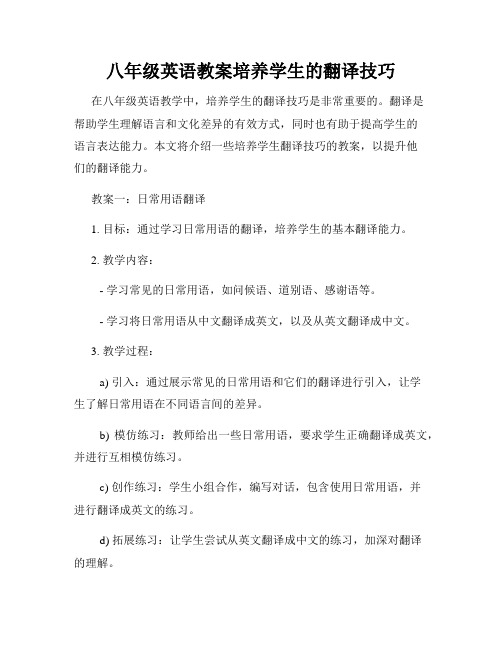
八年级英语教案培养学生的翻译技巧在八年级英语教学中,培养学生的翻译技巧是非常重要的。
翻译是帮助学生理解语言和文化差异的有效方式,同时也有助于提高学生的语言表达能力。
本文将介绍一些培养学生翻译技巧的教案,以提升他们的翻译能力。
教案一:日常用语翻译1. 目标:通过学习日常用语的翻译,培养学生的基本翻译能力。
2. 教学内容:- 学习常见的日常用语,如问候语、道别语、感谢语等。
- 学习将日常用语从中文翻译成英文,以及从英文翻译成中文。
3. 教学过程:a) 引入:通过展示常见的日常用语和它们的翻译进行引入,让学生了解日常用语在不同语言间的差异。
b) 模仿练习:教师给出一些日常用语,要求学生正确翻译成英文,并进行互相模仿练习。
c) 创作练习:学生小组合作,编写对话,包含使用日常用语,并进行翻译成英文的练习。
d) 拓展练习:让学生尝试从英文翻译成中文的练习,加深对翻译的理解。
教案二:课文翻译1. 目标:通过学习课文的翻译,提高学生的语言理解和表达能力。
2. 教学内容:- 学习课文中的重点单词、短语和句子,并进行翻译。
- 学习将整篇课文从中文翻译成英文。
- 学习将整篇课文从英文翻译成中文。
3. 教学过程:a) 引入:教师先导读课文,并提问学生对其中一句话的理解并进行翻译,让学生认识到翻译的重要性。
b) 单词和短语翻译练习:教师给出课文中的重点单词和短语,让学生进行翻译,并进行小组讨论和比较。
c) 句子翻译练习:将部分句子从中文翻译成英文,然后让学生再将其从英文翻译成中文。
d) 完整课文翻译:学生分小组,合作将整篇课文从中文翻译成英文,并进行展示和讨论。
教案三:文化翻译1. 目标:通过学习文化翻译,提高学生理解和表达跨文化差异的能力。
2. 教学内容:- 学习将文化背景下的词语、习语、成语等从中文翻译成英文。
- 学习将跨文化差异的表达从英文翻译成中文。
3. 教学过程:a) 引入:教师通过展示多个国家的标志、成语或习语,让学生感受不同国家的文化差异,并进行简单的讨论。
八年级英语教案提升学生的翻译技巧
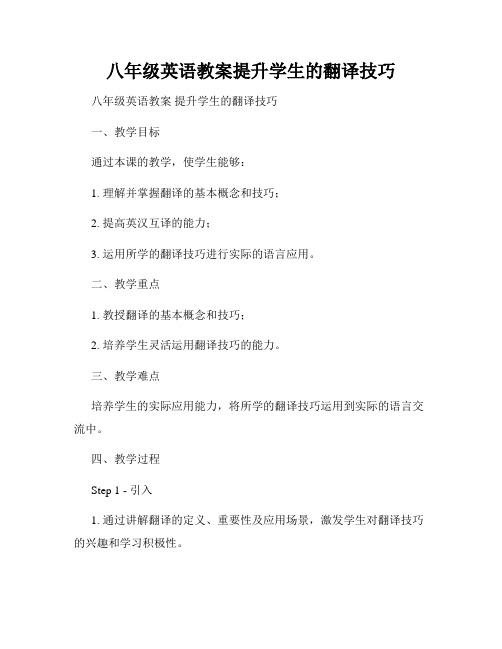
八年级英语教案提升学生的翻译技巧八年级英语教案提升学生的翻译技巧一、教学目标通过本课的教学,使学生能够:1. 理解并掌握翻译的基本概念和技巧;2. 提高英汉互译的能力;3. 运用所学的翻译技巧进行实际的语言应用。
二、教学重点1. 教授翻译的基本概念和技巧;2. 培养学生灵活运用翻译技巧的能力。
三、教学难点培养学生的实际应用能力,将所学的翻译技巧运用到实际的语言交流中。
四、教学过程Step 1 - 引入1. 通过讲解翻译的定义、重要性及应用场景,激发学生对翻译技巧的兴趣和学习积极性。
2. 提问学生:“你在日常生活中遇到过需要进行翻译的场景吗?请举例说明。
”3. 引导学生讨论翻译的难点和常见问题。
Step 2 - 掌握翻译技巧1. 分组进行翻译游戏,让学生运用已学过的句型和词汇进行互译练习,并提醒他们注意翻译过程中的常用技巧和策略。
2. 结合具体例子,讲解常见的翻译技巧,如:词义转换、语序调整、意译等。
3. 小组活动:给学生发放一些中文段落,让他们用英语表达出来,并相互检查、评价对方的翻译。
Step 3 - 提高英汉互译的能力1. 给学生展示一些英文文章,并要求他们尽可能准确地翻译成中文。
2. 学生相互交流自己的翻译结果,共同探讨翻译过程中的问题和解决方法。
3. 教师对学生的翻译结果进行点评,指导他们在翻译过程中更加准确地运用翻译技巧。
Step 4 - 运用翻译技巧进行实际应用1. 学生分组进行小组讨论,选择一段英文材料,并以小组为单位进行翻译。
2. 学生展示自己的翻译成果,并接受其他小组的评价和讨论。
3. 教师对学生的翻译结果进行点评,并总结各组的翻译特点和亮点。
五、教学反思通过本堂课的教学,学生在理解和掌握翻译的基本概念和技巧的同时,也得到了实际运用的机会。
通过小组活动和讨论,培养了学生的合作能力和思辨能力。
课程设置的步骤合理,能够循序渐进地提高学生的翻译能力。
最后,通过对每个小组的翻译结果进行点评,学生得到了具体的指导和反馈,有助于他们进一步提高翻译技巧。
翻译教案培养学生中英文互译能力
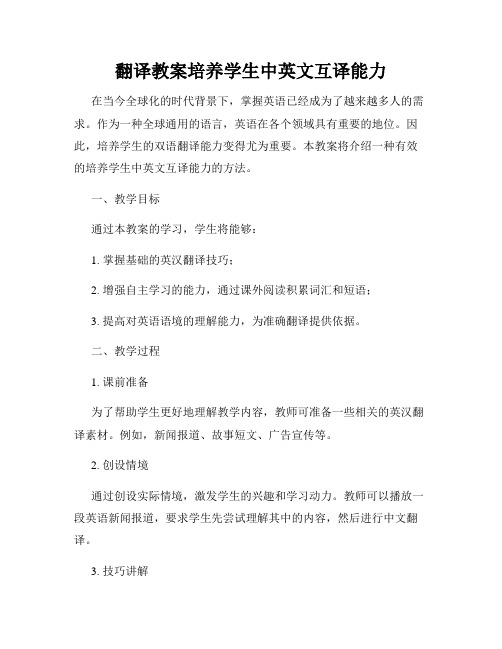
翻译教案培养学生中英文互译能力在当今全球化的时代背景下,掌握英语已经成为了越来越多人的需求。
作为一种全球通用的语言,英语在各个领域具有重要的地位。
因此,培养学生的双语翻译能力变得尤为重要。
本教案将介绍一种有效的培养学生中英文互译能力的方法。
一、教学目标通过本教案的学习,学生将能够:1. 掌握基础的英汉翻译技巧;2. 增强自主学习的能力,通过课外阅读积累词汇和短语;3. 提高对英语语境的理解能力,为准确翻译提供依据。
二、教学过程1. 课前准备为了帮助学生更好地理解教学内容,教师可准备一些相关的英汉翻译素材。
例如,新闻报道、故事短文、广告宣传等。
2. 创设情境通过创设实际情境,激发学生的兴趣和学习动力。
教师可以播放一段英语新闻报道,要求学生先尝试理解其中的内容,然后进行中文翻译。
3. 技巧讲解针对英汉翻译过程中常见的问题和技巧,进行详细的讲解和示范。
例如,语法结构的转换、词汇的选择等。
教师可以通过举例的方式,让学生更好地理解。
4. 练习与反馈提供一些课堂练习,帮助学生巩固所学内容。
教师可以选取一篇短文,要求学生逐句进行中文翻译,并及时给予反馈和指导。
5. 课后拓展鼓励学生进行课外拓展,通过阅读英文原著、观看英文电影等多种方式,扩大词汇量和熟悉语言表达。
三、教学资源1. 数字化教材或教辅书:提供较为系统的英汉翻译练习材料,帮助学生巩固所学内容。
2. 多媒体设备:提供多媒体资源,如英语新闻报道的视频、英文原著的电子书等。
四、教学评价1. 课堂表现评价:通过观察学生在课堂上的参与和表现来评价其对英汉翻译能力的掌握情况。
2. 书面作业评价:布置翻译练习作业,通过学生的作业表现来评价其实际应用能力。
3. 个人口头反馈:为了帮助学生更好地理解自己的翻译问题,教师可选择给予个别学生面对面的反馈和指导。
五、教学反思通过本教案的教学实践,学生在英汉翻译能力方面得到了一定的提升。
然而,由于时间的限制,课堂上只能提供有限的练习机会。
英语翻译教学教学教案
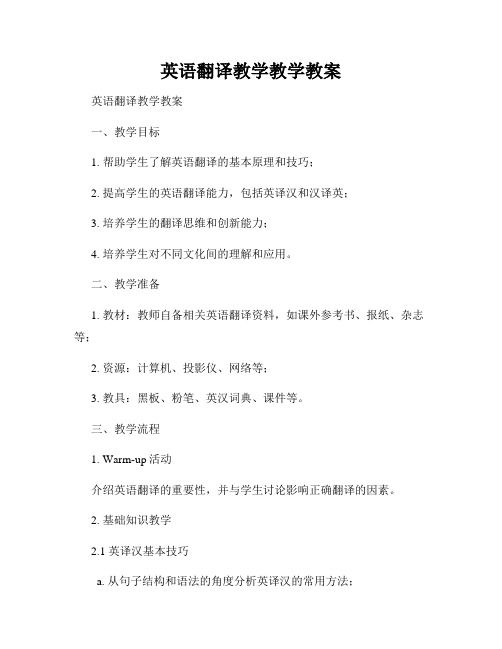
英语翻译教学教学教案英语翻译教学教案一、教学目标1. 帮助学生了解英语翻译的基本原理和技巧;2. 提高学生的英语翻译能力,包括英译汉和汉译英;3. 培养学生的翻译思维和创新能力;4. 培养学生对不同文化间的理解和应用。
二、教学准备1. 教材:教师自备相关英语翻译资料,如课外参考书、报纸、杂志等;2. 资源:计算机、投影仪、网络等;3. 教具:黑板、粉笔、英汉词典、课件等。
三、教学流程1. Warm-up活动介绍英语翻译的重要性,并与学生讨论影响正确翻译的因素。
2. 基础知识教学2.1 英译汉基本技巧a. 从句子结构和语法的角度分析英译汉的常用方法;b. 强调准确理解原文意思并寻找合适的中文表达方式;c. 提示学生在翻译过程中注意文化差异和习惯表达方式的差异。
2.2 汉译英基本技巧a. 分析汉语句子结构和语法规则的基础上进行汉译英;b. 培养学生灵活运用英语词汇和语法知识的能力;c. 强调准确表达意思并注意语言风格、时态等方面的差异。
3. 实践演练3.1 阅读翻译练习a. 提供一段英文文章让学生阅读,然后翻译成中文;b. 分组讨论、互相比较不同译文的优缺点,学生进行讲评。
3.2 书面翻译练习a. 分发一篇汉语文章,要求学生翻译成英文;b. 学生分组进行互评,教师进行点评并给予建议。
4. 拓展应用4.1 图片翻译a. 展示一张图片或者海报,要求学生分组翻译相关的英语文本;b. 学生展示自己的译文,并进行讨论和评价。
4.2 文化差异理解a. 介绍不同国家或地区的节日、习俗、美食等相关知识;b. 提示学生翻译时应注意文化背景和语言习惯的差异。
5. 总结归纳总结本节课的教学内容,并与学生一起讨论遇到的问题和收获。
四、课后作业完成指定的翻译练习,并撰写一篇学习心得。
五、教学反思本节课通过讲授英语翻译的基本原理和技巧,帮助学生提高了翻译能力。
通过实践演练和拓展应用活动,培养了学生的翻译思维和创新能力。
在讲解过程中,应注意呈现清晰、简洁的语言,以保持学生的注意力。
英汉翻译教案范文

英汉翻译教案范文教案:英汉翻译教学目标:1.学生能够准确理解英汉翻译的基本原理和方法。
2.学生能够使用正确的翻译技巧将英文翻译成中文。
3.学生能够运用所学知识,独立完成一篇简单的英汉翻译。
教学重点:1.英汉翻译的基本原理和方法。
2.翻译技巧的运用。
教学难点:1.如何有效运用翻译技巧。
2.如何把握好英汉翻译的语言风格。
教学过程:一、导入(10分钟)1.教师与学生互动,询问学生对英汉翻译的理解。
2.呈现一段英文短文,让学生尝试翻译成中文。
3.学生尝试用翻译软件进行翻译,比较不同翻译结果的准确性和流畅度。
二、基本原理介绍(20分钟)1.教师介绍英汉翻译的基本原理,如准确传递信息、保持语言风格等。
2.教师详细解释基本原理,比如意译和直译的区别、上下文的重要性等。
3.学生通过教师提供的例子,理解原理的应用。
三、翻译技巧讲解(30分钟)1.教师介绍几种翻译技巧,如同义替换、增添补充信息等。
2.教师详细解释各种翻译技巧的使用方法和注意事项。
3.学生通过练习题,运用所学翻译技巧进行翻译。
四、实际操作(30分钟)1.学生分组,每组选择一段英文短文进行翻译。
2.学生在小组内协作,运用所学翻译技巧完成翻译任务。
3.学生将翻译结果展示给全班,并互相评价。
五、总结与反思(10分钟)1.教师总结本节课所学的内容,强化学生对英汉翻译的理解。
2.学生反思自己在翻译过程中遇到的问题和不足。
3.教师给予学生反馈和建议,鼓励学生继续努力提高翻译水平。
教学资源:1.英文短文2.翻译软件3.练习题教学评估:1.学生在小组协作中的表现。
2.学生翻译的准确性和流畅度。
3.学生对翻译技巧的理解和运用。
教学延伸:1.学生可以进一步学习翻译的高级技巧和技巧,如词汇选择、语法转换等。
2.学生可以自主扩展翻译技能,进行更复杂的翻译任务。
教学反思:1.教学目标和重点难点的设置是否合理。
2.教学过程是否能够激发学生的学习兴趣和主动性。
3.教学资源的充分利用和教学评估的准确性。
《文言文翻译技巧》教案

板书设计应具有一定的艺术性和趣味性,以激发学生的学习兴趣和主动性。例如,可以使用图形、颜色、图片等元素来吸引学生的注意力,同时,可以设计一些有趣的练习题,让学生在轻松愉快的氛围中学习。
示例板书设计:
1.基本原则:直译为主,意译为辅
2.句式结构:主谓宾结构
3.词汇短语:一词多义、通假字
3.文化意识:通过学习文言文翻译技巧,学生能够更好地理解古代文化,增强自己的文化素养。
4.学习能力:通过自主学习、合作学习和探究学习等方式,学生能够培养自己的学习兴趣,提高学习文言文的积极性和主动性。
学情分析
学生在进入本节课之前,已经具备了一定的文言文基础知识,对一些常见的文言文词汇和句式有一定的了解。在学习过程中,他们能够基本的阅读和理解简单的文言文文章。然而,学生在文言文翻译方面还存在一些问题,如对文言文特殊句式的理解不准确,对古代文化背景的了解不足,以及对一些文言文词汇的多义性掌握不够等。
目标:培养学生的合作能力和解决问题的能力。
过程:
将学生分成若干小组,每组选择一个与文言文翻译技巧相关的主题进行深入讨论。
小组内讨论该主题的现状、挑战以及可能的解决方案。
每组选出一名代表,准备向全班展示讨论成果。
5.课堂展示与点评(15分钟)
目标:锻炼学生的表达能力,同时加深全班对文言文翻译技巧的认识和理解。
在学习行为习惯方面,学生们通常具备良好的学习习惯,能够按时完成作业和参与课堂活动。他们乐于与同学合作学习,共同解决问题。然而,部分学生在课堂讨论中可能较为内向,不善于表达自己的观点和想法,需要教师的鼓励和引导。
对于课程学习的影响,学生们的知识水平和能力素质将对文言文翻译技巧的学习产生直接影响。对于那些已经具备一定基础的学生,他们能够更好地理解和运用所学的翻译技巧。然而,对于那些基础较为薄弱的学生,他们可能需要更多的支持和辅导,以便能够跟上课堂的进度。
初中中英互译教案
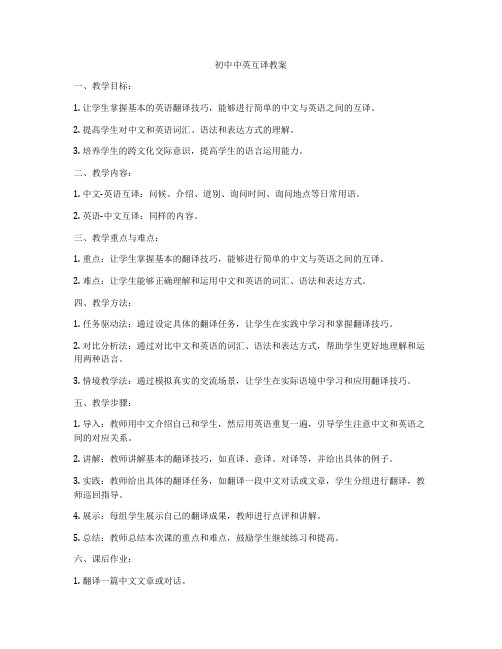
初中中英互译教案一、教学目标:1. 让学生掌握基本的英语翻译技巧,能够进行简单的中文与英语之间的互译。
2. 提高学生对中文和英语词汇、语法和表达方式的理解。
3. 培养学生的跨文化交际意识,提高学生的语言运用能力。
二、教学内容:1. 中文-英语互译:问候、介绍、道别、询问时间、询问地点等日常用语。
2. 英语-中文互译:同样的内容。
三、教学重点与难点:1. 重点:让学生掌握基本的翻译技巧,能够进行简单的中文与英语之间的互译。
2. 难点:让学生能够正确理解和运用中文和英语的词汇、语法和表达方式。
四、教学方法:1. 任务驱动法:通过设定具体的翻译任务,让学生在实践中学习和掌握翻译技巧。
2. 对比分析法:通过对比中文和英语的词汇、语法和表达方式,帮助学生更好地理解和运用两种语言。
3. 情境教学法:通过模拟真实的交流场景,让学生在实际语境中学习和应用翻译技巧。
五、教学步骤:1. 导入:教师用中文介绍自己和学生,然后用英语重复一遍,引导学生注意中文和英语之间的对应关系。
2. 讲解:教师讲解基本的翻译技巧,如直译、意译、对译等,并给出具体的例子。
3. 实践:教师给出具体的翻译任务,如翻译一段中文对话或文章,学生分组进行翻译,教师巡回指导。
4. 展示:每组学生展示自己的翻译成果,教师进行点评和讲解。
5. 总结:教师总结本次课的重点和难点,鼓励学生继续练习和提高。
六、课后作业:1. 翻译一篇中文文章或对话。
2. 总结自己在翻译过程中遇到的问题和解决方法。
3. 预习下一节课的内容。
七、教学评价:1. 课堂参与度:观察学生在课堂上的积极参与情况和表现。
2. 翻译成果:评估学生在翻译任务中的表现和成果。
3. 课后作业:检查学生的课后作业完成情况和质量。
通过本节课的教学,希望学生能够掌握基本的翻译技巧,提高中文和英语的互译能力,为今后的学习和生活打下坚实的基础。
英语口语逐句翻译技巧教案
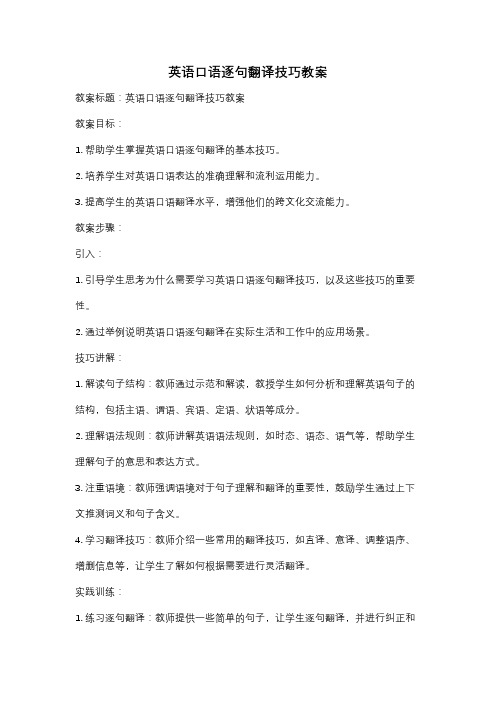
英语口语逐句翻译技巧教案教案标题:英语口语逐句翻译技巧教案教案目标:1. 帮助学生掌握英语口语逐句翻译的基本技巧。
2. 培养学生对英语口语表达的准确理解和流利运用能力。
3. 提高学生的英语口语翻译水平,增强他们的跨文化交流能力。
教案步骤:引入:1. 引导学生思考为什么需要学习英语口语逐句翻译技巧,以及这些技巧的重要性。
2. 通过举例说明英语口语逐句翻译在实际生活和工作中的应用场景。
技巧讲解:1. 解读句子结构:教师通过示范和解读,教授学生如何分析和理解英语句子的结构,包括主语、谓语、宾语、定语、状语等成分。
2. 理解语法规则:教师讲解英语语法规则,如时态、语态、语气等,帮助学生理解句子的意思和表达方式。
3. 注重语境:教师强调语境对于句子理解和翻译的重要性,鼓励学生通过上下文推测词义和句子含义。
4. 学习翻译技巧:教师介绍一些常用的翻译技巧,如直译、意译、调整语序、增删信息等,让学生了解如何根据需要进行灵活翻译。
实践训练:1. 练习逐句翻译:教师提供一些简单的句子,让学生逐句翻译,并进行纠正和反馈。
2. 对话练习:教师设计一些对话情境,让学生进行逐句翻译,并进行角色扮演,提高口语表达能力。
3. 阅读理解:教师选取一篇适合学生水平的英语文章,让学生进行逐句翻译,并进行讨论和解读。
总结:1. 教师总结本节课的重点和要点,强调学生在平时学习中的应用和实践。
2. 鼓励学生多进行口语练习,提高口语逐句翻译的技巧和流利度。
扩展活动:1. 学生自主翻译:鼓励学生选择一段自己感兴趣的英语文本,进行逐句翻译,并与同学分享。
2. 录音练习:要求学生进行口语练习,并录音自己的表达,以便自我评估和改进。
教案评估:1. 教师观察学生在课堂练习中的表现,包括准确性、流利度和理解能力。
2. 学生之间互相评价和反馈,帮助他们发现问题和改进。
教案资源:1. 英语口语教材和练习册。
2. 适合学生水平的英语文章和对话材料。
3. 录音设备或手机录音功能。
《英汉互译》教案与讲义
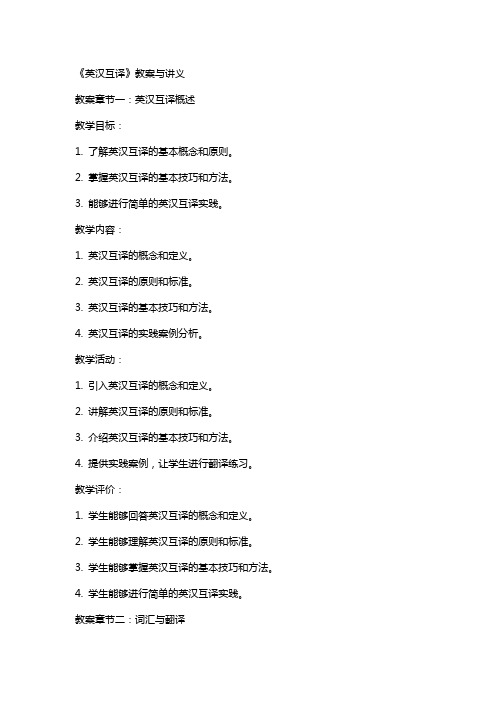
《英汉互译》教案与讲义教案章节一:英汉互译概述教学目标:1. 了解英汉互译的基本概念和原则。
2. 掌握英汉互译的基本技巧和方法。
3. 能够进行简单的英汉互译实践。
教学内容:1. 英汉互译的概念和定义。
2. 英汉互译的原则和标准。
3. 英汉互译的基本技巧和方法。
4. 英汉互译的实践案例分析。
教学活动:1. 引入英汉互译的概念和定义。
2. 讲解英汉互译的原则和标准。
3. 介绍英汉互译的基本技巧和方法。
4. 提供实践案例,让学生进行翻译练习。
教学评价:1. 学生能够回答英汉互译的概念和定义。
2. 学生能够理解英汉互译的原则和标准。
3. 学生能够掌握英汉互译的基本技巧和方法。
4. 学生能够进行简单的英汉互译实践。
教案章节二:词汇与翻译1. 了解词汇在英汉互译中的重要性。
2. 掌握英汉词汇的差异和转换方法。
3. 能够准确翻译词汇和短语。
教学内容:1. 词汇在英汉互译中的作用和重要性。
2. 英汉词汇的差异和转换方法。
3. 常见词汇和短语的翻译实例。
教学活动:1. 引入词汇在英汉互译中的作用和重要性。
2. 讲解英汉词汇的差异和转换方法。
3. 提供常见词汇和短语的翻译实例。
4. 让学生进行词汇翻译练习。
教学评价:1. 学生能够理解词汇在英汉互译中的重要性。
2. 学生能够掌握英汉词汇的差异和转换方法。
3. 学生能够准确翻译常见词汇和短语。
教案章节三:语法与翻译教学目标:1. 了解语法在英汉互译中的重要性。
2. 掌握英汉语法的差异和转换方法。
3. 能够正确翻译句子和段落。
1. 语法在英汉互译中的作用和重要性。
2. 英汉语法的差异和转换方法。
3. 常见语法错误的分析和纠正。
教学活动:1. 引入语法在英汉互译中的作用和重要性。
2. 讲解英汉语法的差异和转换方法。
3. 提供常见语法错误的分析和纠正。
4. 让学生进行句子和段落的翻译练习。
教学评价:1. 学生能够理解语法在英汉互译中的重要性。
2. 学生能够掌握英汉语法的差异和转换方法。
幼儿园翻译技巧教案

幼儿园翻译技巧教案随着全球化的发展,语言交流在我们日常生活中变得越来越重要。
在幼儿园教育中,翻译技巧是一项关键的能力,能够帮助幼儿更好地理解和沟通。
本文将探讨一些幼儿园翻译技巧,帮助教师们更好地教授这一能力。
第一部分:翻译的重要性在幼儿园教育中,翻译是一项至关重要的技能。
幼儿正处于语言习得的关键阶段,他们需要通过翻译来理解和表达自己的想法。
翻译可以帮助幼儿扩大他们的词汇量,提高他们的语言能力,并促进他们的跨文化交流。
第二部分:幼儿园翻译技巧1. 使用简单明了的语言幼儿的语言能力有限,因此在进行翻译时,教师应使用简单明了的语言。
避免使用过于复杂的词汇和句子结构,以免幼儿难以理解。
2. 利用肢体语言和表情幼儿对于肢体语言和表情有着强烈的感知能力。
教师可以通过手势、面部表情和身体动作来辅助翻译,帮助幼儿更好地理解和表达。
3. 创造情境创造情境是一种有效的翻译技巧。
通过将语言与实际生活情境相结合,幼儿可以更好地理解和运用所学的语言知识。
教师可以设计各种游戏和活动,让幼儿在实践中学习翻译。
4. 引导幼儿思考翻译不仅仅是简单地将一种语言转化为另一种语言,还需要理解和传达语言背后的意义。
教师可以通过提问和引导幼儿思考,帮助他们理解和表达更深层次的意义。
第三部分:培养幼儿的翻译技巧1. 提供丰富的语言环境为了培养幼儿的翻译技巧,教师应提供丰富的语言环境。
这包括使用多种语言教材、播放多语种的音频和视频,以及邀请外籍教师或家长参与教学活动。
2. 组织语言交流活动语言交流活动是培养幼儿翻译技巧的有效方式。
教师可以组织小组讨论、角色扮演和语言游戏等活动,鼓励幼儿使用所学的语言进行交流和翻译。
3. 鼓励幼儿多语种学习多语种学习可以帮助幼儿更好地理解和应用不同语言之间的差异。
教师可以鼓励幼儿学习多种语言,例如英语、汉语、西班牙语等,以提高他们的翻译能力。
4. 培养幼儿的跨文化意识翻译技巧与跨文化意识密切相关。
教师应通过教学活动和故事讲解等方式,培养幼儿对不同文化和语言的理解和尊重,以提高他们的翻译能力。
中学语文文言文翻译技巧教案

中学语文文言文翻译技巧教案1. 前言在学习语文课程中,文言文翻译一直是中学生的难点和重点。
为了帮助学生掌握文言文翻译技巧,提高翻译能力,本教案特别设计了一些实用的技巧和方法,供学生参考和学习。
2. 理解文言文的特点在进行文言文翻译之前,我们首先需要了解文言文的特点。
文言文是中国古代的书面语言,与现代汉语存在很大差异。
文言文具有严谨、简练和充满修辞的特点,而且使用了许多古代汉字和词语。
因此,学生在翻译文言文时需要注重古汉字的理解和正确运用。
3. 确定文言文翻译的目标在进行文言文翻译时,我们需要明确翻译的目标。
有时候,我们可以选择按字面意思进行翻译,保持文言文的古风。
有时候,我们也可以选择按意译的方式,用现代汉语表达相同的意思。
无论哪种方式,都需要保证翻译的准确性和通顺性。
4. 掌握常见文言文翻译技巧4.1 字词翻译技巧在翻译文言文时,我们需要注意一些常见字词的翻译技巧。
比如,"吾"可以翻译为"我","儿"可以翻译为"的"等。
同时,我们还需要了解一些文言文的特殊用法,例如"不可胜"可以翻译为"不能胜过"等。
4.2 句子结构翻译技巧文言文句子结构复杂,有时候需要颠倒语序,才能符合现代汉语的表达习惯。
在翻译句子结构时,可以根据文言文的语法特点,灵活运用各种翻译方法,使译文更加通顺。
4.3 修辞手法翻译技巧文言文具有丰富的修辞手法,如比喻、夸张、反问等。
在翻译修辞手法时,我们需要在保持句意的基础上,尽量还原文言文的修辞效果。
5. 练习与总结为了提高语文学生的文言文翻译能力,我们可以设计一些练习题,让学生进行实践。
在练习过程中,学生可以逐渐熟悉文言文的特点,掌握常见的翻译技巧。
练习后,可以与同学们一起总结经验,互相交流,共同进步。
6. 结束语文言文翻译是语文学习中的一项重要任务,也是提高语文能力的关键环节。
翻译技巧与赏析教案

翻译技巧与赏析教案
教案标题:翻译技巧与赏析教案
教学目标:
1. 了解翻译的基本技巧和原则
2. 提高学生的翻译能力和水平
3. 培养学生对翻译作品的赏析能力
教学重点和难点:
重点:翻译的基本技巧和原则,翻译作品的赏析
难点:如何运用翻译技巧将原文表达准确地转化成目标语言
教学准备:
1. 教学课件、教学素材
2. 翻译作品范例
3. 学生练习题和作业
教学过程:
一、导入
通过引入一段有趣的翻译作品或者名言引起学生的兴趣,引导学生思考翻译的重要性和意义。
二、讲解翻译的基本技巧和原则
1. 语言转换:介绍不同语言之间的差异,如语法、词汇、句式等,以及如何进行准确的语言转换。
2. 文化转换:讲解翻译时需要考虑到文化差异,如习惯用语、礼貌用语等的转换。
3. 表达准确性:强调翻译的准确性和忠实性,避免误译和歧义。
三、翻译技巧的实践
1. 给学生提供一些短文或句子,让他们运用所学的翻译技巧进行翻译练习。
2. 教师进行示范,指导学生如何根据上述翻译技巧进行翻译,解释其中的难点和注意事项。
四、翻译作品的赏析
1. 选取一些优秀的翻译作品,让学生进行赏析,分析翻译的优缺点和特色。
2. 引导学生思考翻译作品的背后文化内涵和语言特点,培养他们的文化意识和语言感知能力。
五、课堂练习和作业
布置相关的练习题和作业,让学生巩固所学的翻译技巧和赏析能力。
教学反思:
教师可以通过学生的课堂表现和作业情况来评估教学效果,及时调整教学方法和内容,以提高学生的翻译能力和水平。
高中翻译技巧教案教授学生翻译技巧和常见问题解决方法

高中翻译技巧教案教授学生翻译技巧和常见问题解决方法高中翻译技巧教案:教授学生翻译技巧和常见问题解决方法在当今全球化的时代里,翻译技巧成为越来越重要的能力。
高中学生作为未来社会的中流砥柱,他们需要掌握一定的翻译技巧,以准确有效地传达信息。
本文将介绍一份高中翻译技巧教案,旨在教授学生翻译技巧和常见问题解决方法。
一、翻译技巧1. 熟悉文化背景翻译不仅仅是语言的转换,还涉及到文化差异。
学生应该了解源语言和目标语言的文化背景,以确保准确传达信息,并避免因文化差异引起的误解。
2. 词汇扩充学生需要不断扩充自己的词汇量,特别是相关领域的专业术语。
可以通过阅读、背单词、记忆词义等方式来增强词汇能力。
3. 注意语法和语义在翻译过程中,语法和语义的准确性至关重要。
学生应该注重语法知识的学习,并能够理解句子结构和语义关系,以确保翻译结果的准确性。
4. 保持风格一致翻译技巧也包括保持文本的风格一致性。
学生需要了解不同类型的文本风格,如学术文献、新闻报道、文艺作品等,并在翻译中保持相应的风格特点。
二、常见问题解决方法1. 歧义翻译在翻译过程中,可能会遇到一词多义或者多词一义的情况,导致歧义翻译。
学生需要通过上下文判断词义,或者进行必要的补充说明,以避免歧义。
2. 文化差异文化差异可能导致翻译的难度增加。
学生需要注意不同文化之间的差异,并结合上下文和背景信息,进行恰当的翻译。
3. 文体转换有些文本在不同语言中的表达方式可能存在差异,学生需要灵活运用翻译技巧,将原文的文体特点转换到目标语言中。
4. 语法结构调整不同语言的语法结构有所不同,学生在翻译时需要根据目标语言的语法规则进行结构调整,以确保翻译的流畅和准确。
本教案旨在提高学生的翻译能力,培养他们准确有效地传达信息的能力。
通过掌握翻译技巧和解决常见问题的方法,学生可以更好地应对各种翻译任务,并提升自己的语言水平。
总结起来,高中翻译技巧教案的编写目的在于教授学生翻译技巧和解决问题的方法。
翻译技巧教学案例

翻译技巧教学案例引言:在全球化的今天,翻译成为了跨国交流和沟通的重要手段。
然而,翻译并不是一项简单的工作,需要掌握一定的技巧和方法,才能实现准确、流畅的翻译。
本教案将重点介绍几种实用的翻译技巧,并通过实例进行具体分析,帮助学生提高翻译能力。
1. 背景知识与文化意识的重要性翻译工作离不开对背景知识的了解和文化意识的把握。
学生首先需要熟悉源语言和目标语言的相关背景知识,包括文化、历史、地理等方面的内容。
然后,他们要意识到不同语言和文化间的差异,避免直译和传达差异。
例如,英文中的“red tape”指的是繁文缛节的官僚主义,而在汉语中我们可能会用“官僚主义”或其他词汇来表达这个意思。
因此,了解背景知识和文化意识是翻译中不可或缺的一环。
2. 上下文理解与准确表达上下文的理解对于翻译的准确性和流畅性至关重要。
学生在进行翻译时,不仅需要理解源语言的上下文,还要能够准确地表达目标语言中的上下文信息。
例如,源语言中的句子“他把心一横,决心放弃工作。
”其中“把心一横”是一个习语,如果直译成目标语言可能会让读者产生困惑。
因此,学生在翻译时要注意上下文的理解,并选择恰当的目标语言表达。
3. 结构对应与句型转换不同语言之间存在着不同的句法结构和表达方式。
在翻译过程中,学生需要进行结构对应和句型转换,使得目标语言的表达更符合习惯。
例如,源语言中的句子“他正在研究一本有关机器学习的书。
”要翻译成英文,可以转换为“He is studying a book on machine learning.”其中,目标语言采用了更常见的主语+谓语+宾语的结构。
学生在翻译时要灵活运用句型转换和结构对应的技巧。
4. 翻译工具的运用随着科技的发展,各种翻译工具也层出不穷。
学生可以合理利用翻译工具来提高效率,但也要注意工具的局限性。
例如,学生在翻译某个词语时可以使用在线词典或翻译软件来查找备选词汇,并根据上下文选择合适的译词。
然而,翻译工具有时也会出现错误或不准确的翻译结果,学生要保持批判思维,不盲目依赖工具。
- 1、下载文档前请自行甄别文档内容的完整性,平台不提供额外的编辑、内容补充、找答案等附加服务。
- 2、"仅部分预览"的文档,不可在线预览部分如存在完整性等问题,可反馈申请退款(可完整预览的文档不适用该条件!)。
- 3、如文档侵犯您的权益,请联系客服反馈,我们会尽快为您处理(人工客服工作时间:9:00-18:30)。
Introduction to TranslationI. Teaching Objectives:●To introduce the students the history of translation●To introduce the students the definiton of translation and its classification ●To help the students realize the importance of translationII. Important points:●The defintion of translation ---- cross-linguistic, cross-cultural,cross-socialIII. Time allotment: 2 periodsIV. Teaching procedures:1. lead-inA story in bible which told how important translation was in the world.2. The history of translation:five climaxes abroad, four climaxes at home3. The definiton of translation:a. to turn from one language into another (The Oxford English Dictionary)b. to turn itno one’s own or another language (Webster’s Third New International Dictionary of the English language)4. The classification of translationIntralingual translation/interlingual translationInterpretation/translation5. PreviewTranslation standardI. Teaching Objectives:●To introduce variaties of theories about translation standard proposed bydifferent scholars●To help the students learn the basic principles in translating as beginners II.Important points:Faithfullness and smoothnessIII. Difficult pointsYan Fu: “信”, “达”, “雅”IV. Time allotment: 2 periodsⅤ. Teaching procedures:1. Various theories:a.Geogre Campbell (English translator): The first thing... is to give a justrepresentation of the sense of the original... The second thing is, to convey into his version, as much as possible, in a consistency with the genius of the language which he writes, the author’s spirit and manner...The third adn last thing is, to take care, the version have at least, so far the quality of anoriginal performance, as to appear natural and easy...(Venuti, 1995:75) b.Lefevere: 1. That the translation should give a complete transcript of theideas of the original work. 2. That the style and manner of writing should be of the same character with that of the original. 3. That the translation should have all the ease of original composition.(Lefevere, 1992b, 128) c.严复:信、达、雅从严复本人对信达雅的解释来看,所谓“信”是意义不倍(背)本文,即忠实。
“达”指不拘泥于原文的用词造句,而尽译语言这能事以求语义明显,近乎通顺。
“雅”则要求译文必须用“汉以前的字法句法”,故可求其尔雅。
但他又主张“与其伤雅,毋宁失真”,除特殊情况外,似有过分强调文笔优美的倾向。
2. Basic principles for beginners概括起来,翻译要解决的根本问题有两个,一是“忠实”的问题,二是“通顺”的问题。
所谓忠实,首先指要忠实于原作的思想内容,一般情况下,译者应把原作的思想内容完整而准确地传达出来,不得无端加以篡改、歪曲、遗漏或增删。
这里所说的思想内容,通常指作品中所叙述的事实,说明的事理,描写的人物,以及作者在叙述、说明、描写的过程中反映的立场观点,所流露的思想情感。
忠实还指保持原作的风格。
所谓通顺,是指译文语言必须通顺易懂,合乎规范。
在翻译中,忠实与通顺是一个矛盾统一体的两个方面,二者相辅相成,不可割裂。
忠实而不通顺,读者看不懂,或者看不下去,忠实便失去意义,实际上就是不忠实;通顺而不忠实,读者看倒可能看下去,但是得到的是被歪曲的信息,其危害比忠实而不通顺还要严重。
3. Example(E-C):a. The commuter dies with tremendous mileage to his credit.b. I was with my father on a business-and-pleasure trip.c. Size don’t matter, chopping wood...4. From there I could see the whole valley below, the fields, the river, and the village. It was all very beautiful, and the sight of it filled me with longing.4. Preview and exercisesLecture ThreeLiteral translation/idiomatic translation(直译和意译)I. Teaching Objectives:●To introduce literal translation and idiomatic translation●To distinguish literal translation and idiomatic translationII.Important points:Difference between literal translation and idiomatic translationIII. Difficult pointsDifference between literal translation and idiomatic translationIV. Time allotment: 2 periodsⅤ. Teaching procedures:1.preview: faithfulness and smoothness2.直译所谓直译(literal translation)并非完全不考虑英汉词义的不同和句式的差别去机械地进行词对词翻译(word-for-word translation),而是在考虑这些差异并照顾原文表达形式的前提下允许译者针对原文在短语层次上作必要的调整。
换言之,在译文中既保持原文内容,又保持原文的形式,对原文的谴词造句、比喻形象一般不做大的变动,即使变动也是为了照顾到译入语的规范和流畅。
3.意译所谓意译也不完全是无拘无束的自由翻译(free translation),而是在原文表达形式与译文表达形式发生矛盾时采用适当变通原文形式甚至改变原文形式的方法,使译文尽量符合译入语的表达习惯和原作的深层含义,从而读起来近乎用译入语直接写出的文本。
4.区别实际上,直译意译只是在切分对应层次的单位大小上有区别,并无实质性的区别。
前者以词和短语结构为基本对应单位,后者则扩大到瓬与句短以求得更大范围内的翻译对应值。
5.Example实例a.But I hated Skamoto, and I had a feeling he’d surely lead us both to ouranlestors.b.Hitler was armed to the teeth when he lauched the second World War, butin a few years, he was completely defeated.c.Don’t cross the bridge till you get to it.d.Do you see any green in my eye?e.To kill two birds with one stone.f.To shed crocodile tears6. ExercisesLecture FourDomestication/foreignizationI. Teaching Objectives:●To introduce the students domestication and foreignization●To help the students tell the difference between domestication andforeignization●To help the students tell the difference between literal translation andforeignization and the difference between idiomatic translation and domesticationII.Important points:Domestication and foreignizationIII. Difficult pointsDifference of two groups of conceptsIV. Time allotment: 2 periodsⅤ. Teaching procedures:1.preview: literal translation and idiomatic translation2.异化与归化及区别异化和归化作为两个互相关联的对应概念,还是在翻译研究出现“文化转向”之后,于1995年同美国翻译理论家劳伦斯·韦努蒂在《译者的隐形》(The Translator’s Invisibility)一书中提出的。
